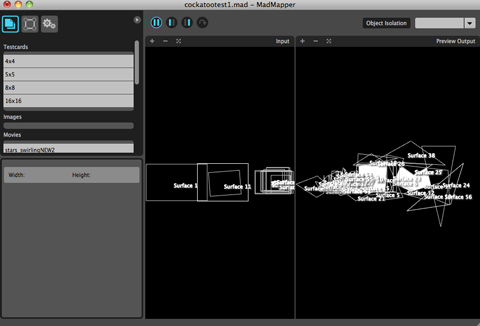

- Madmapper tutorial project on tree mac os x#
- Madmapper tutorial project on tree full#
- Madmapper tutorial project on tree software#
- Madmapper tutorial project on tree code#
- Madmapper tutorial project on tree download#
Take a look at the code in SyphonClientTexture. SyphonClient: if you want to use a Projector as a Syphon client, add the SyphonClientTextureProjector script to a gameObject that has a Projector on it, and then in its public inspector fields, add the name and appName of the client. If you don't care about the alpha channel, and want to ensure your Syphon output texture looks the same as it does in the Unity game view, put a SyphonServerAlphaOne script on the camera. See the unity scene SyphonServerCustomResolution. If you want a quick way to use Unity as a control surface, where its GUI is only visible inside the Unity app itself, additionally take a look at the code in ControlSurfaceExample. On the SyphonClientTexture, in the public inspector fields, add the name and appName of the client you just added.įor advanced users Syphon Server: if you want to output a custom resolution video texture i.
Madmapper tutorial project on tree software#
Post to Cancel.Create your free GitHub account today to subscribe to this repository for new releases and build software alongside 40 million developers.
Madmapper tutorial project on tree download#
You can download a demo version here MadMapper works in a fundamentally different way to QLab.

The simplest example of this would be if you set the block pyramid up in a new space and the projector was slightly out of line with the original set up. The ability to move and rotate multiple surfaces simultaneously in a single window can really speed up many workflows. QLab and MadMapper are a very powerful and stable combination for all sorts of mapping tasks. This only really scratches the surface of what QLab in combination with MadMapper is capable of. QLab is only having to play 4 videos during the crossfade. This is the equivalent of 60 surfaces of video playing simultaneously if we were attempting this only using QLab.Īgain, the video performance is completely smooth. We can now set up crossfading to the new images. QLab is coasting along as it is only playing 1 video. In Mad Mapper you can select, duplicate, move and rotate multiple surfaces simultaneously so you can quite rapidly map some more cubes. When we play this cue in QLab it appears in the source image window in Mad Mapper. The Syphon server created mirrors the entire surface, so all the geometry controls are locked out. This is one example where QLab needs a dedicated mapping program to sit between it and the projector output. On most systems this will exceed all practical limits and, as in the example video, the program will freeze. However, the major problem is at this point QLab is attempting to play 36 video cues simultaneously on 18 surfaces The existing video on 3 faces of each of the 6 cubes and a further 18 cues crossfading these to the new video image. This is quite a lot of programming, and the re-targeting of many cues individually would have to be done every time we wanted the video images on the cubes to change. There are now a lot of dropped frames, so completing the bottom row may not be an option. There are now 18 video cues assigned to 18 surfaces. The next video shows the state of the mapping after 6 cubes are completed.
Madmapper tutorial project on tree full#
The video will be clearer if viewed full screen. Here is a video of it in action double speed. We then want to crossfade all the images to a different set of top, left, and right images. A stack of cubes arranged in a pyramid, 4 rows high, presents 3 visible faces of 10 cubes to a projector. This is in contrast to QLab where each video cue even though it may use the same file as another can only be routed to a single surface. It takes an input video source, defined geometric areas of which can be defined as surfaces.

MadMapper works in a fundamentally different way to QLab. This example uses MadMapper as the Syphon client. QLab can also function as a Syphon client so you can use other programs as an input to QLab, e. QLab has an easily accessed Syphon server built in so it can share video with any software that can function as a Syphon client.
Madmapper tutorial project on tree mac os x#
Syphon is an open source Mac OS X technology that allows applications to share frames - full frame rate video or stills - with one another in real-time.

This tutorial illustrates why, and when, you might want to use a standalone mapping program as your final video output from QLab to projectors, instead of using multiple surfaces within QLab.


 0 kommentar(er)
0 kommentar(er)
